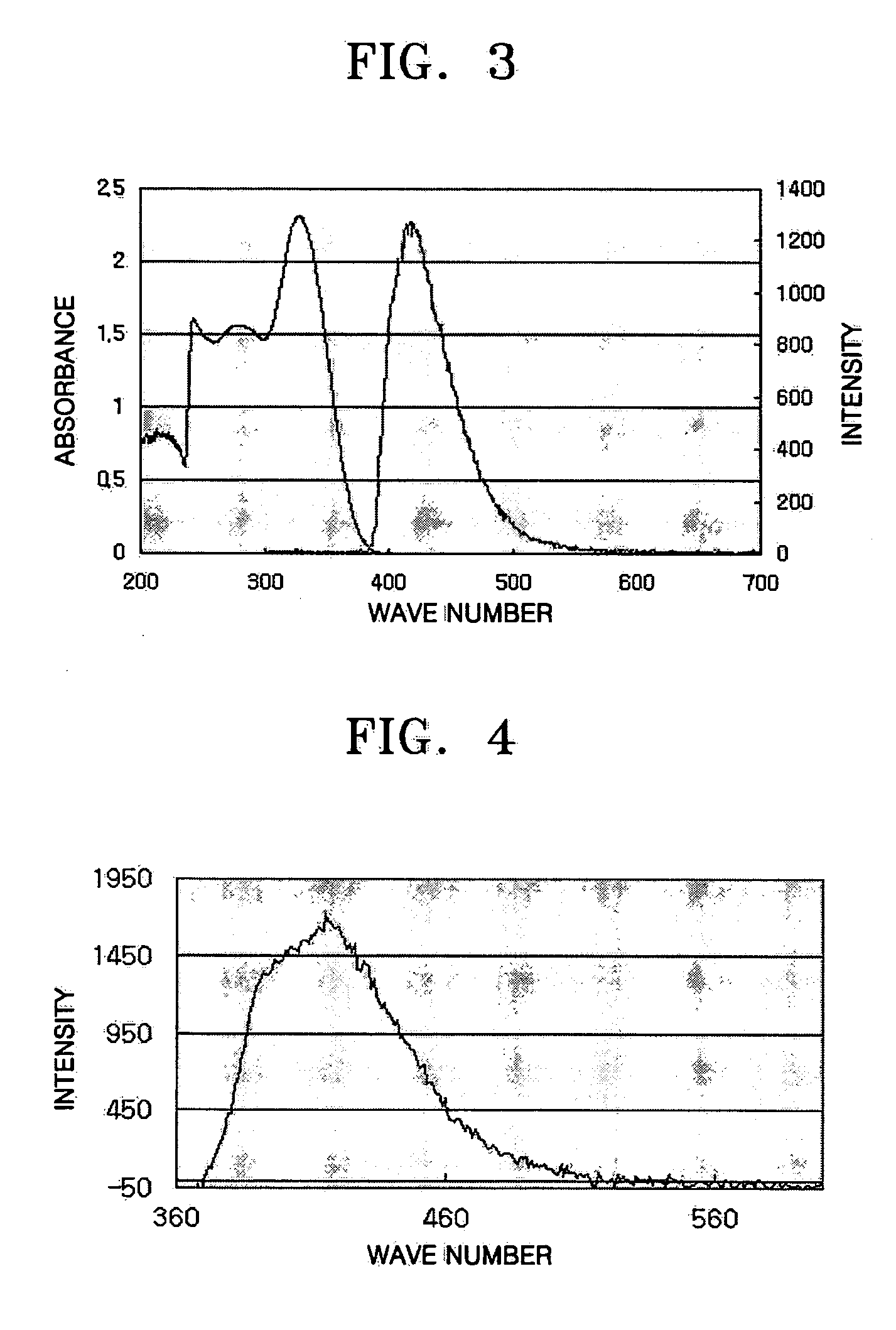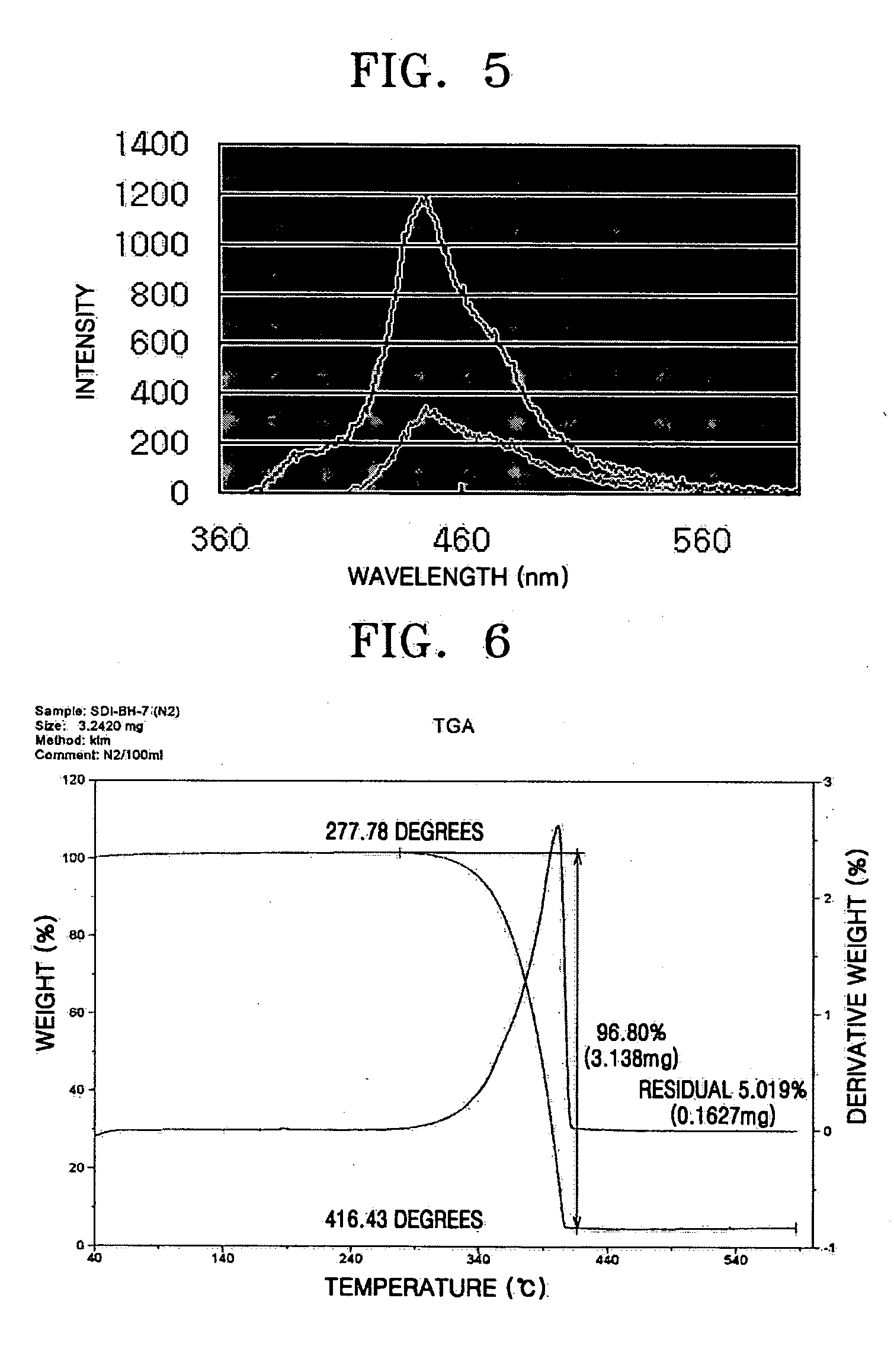Imidazole ring-containing compound and organic electroluminescence display device
- Summary
- Abstract
- Description
- Claims
- Application Information
AI Technical Summary
Benefits of technology
Problems solved by technology
Method used
Image
Examples
specific example 1
Synthesis of compound (VIII-2)
Compound (VIII-2) was synthesized according to Reaction scheme (1) below.
Synthesis of Intermediate (A)
6 g (50 mmol) of bromoacetophenone was dissolved in 250 ml of DME, and 10 g (50 mmol) of 2-aminothiazole in solid state was added to the solution, stirred for 5 hours at room temperature, and refluxed for 12 hours. The reaction product was distilled in a reduced pressure to remove the solvent, and 250 ml of dichloromethane was added to dissolve the remaining product. The pH of the solution was adjusted to pH 10 using a 10% sodium carbonate solution to separate the dichloromethane phase. The remaining aqueous phase was extracted twice using 200 ml of dichloromethane. The collected organic phase was dried using magnesium sulfate and the solvent evaporated from the dried product, and the resulting product was purified by silica gel column chromatography to obtain 8.4 g of intermediate (A) with a yield of 84%.
Synthesis of Intermediate (B)
1 g of i...
specific example 2
Synthesis of Compound (VIII-3)
Compound (VIII-3) was synthesized according to Reaction scheme (2) below.
Synthesis of Intermediate (D)
100 mg (0.42 mmol) of intermediate (C) and 250 mg (1.05 mmol) of 1,4-dibromobenzene were dissolved in 5 ml of THF. 10 mg (0.008 mmol) of tetrakistriphenylphosphinepalladium and a solution of 580 mg (4.2 mmol) of K2CO3 in 3 ml of distilled water were sequentially added and stirred at 75° C. for 12 hours. The reaction solution was extracted three times using 10 ml of ethyl acetate each time. The collected organic phase was dried using magnesium sulfate and the solvent evaporated from the dried product. Then, the resulting product was purified by silica gel column chromatography to obtain 100 mg of intermediate (D) with a yield of 67%. The structure of intermediate (D) was identified by 1H NMR as follows: 1H NMR (CDCl3, 400 MHz) δ (ppm) 7.78 (s, 1H), 7.75-7.73 (m, 1H), 7.60-7.55 (m, 3H), 7.54-7.50 (m, 3H), 7.46-7.43 (m, 1H), 7.37-7.31 (m, 2H), 1.53 ...
specific example 3
Synthesis of Compound (VIII-5)
Compound (VIII-5) was synthesized according to Reaction scheme (3) below.
Synthesis of Intermediate (F)
335 mg (2 mmol) of carbazole, 1.2 g (5 mmol) of 1,4-dibromobenzene, 76 mg (0.4 mmol) of CuI, 1.1 g (8 mmol) of K2CO3 (1.1 g, 8 mmol), and 10 mg (0.04 mmol) of 18-Crown-6 were dissolved in 5 ml of DMPU (1,3-Dimethyl-3,4,5,6-tetrahydro-(1H)-pyrimidinone) and heated at 170° C. for 8 hours. After cooling to room temperature, the solid reaction product was filtered off, and a small amount of ammonia water was added to the filtrate, followed by washing three times using 10 ml of diethyl ether each time. The washed diethyl ether phase was dried using MgSO4 under reduced pressure to obtain a crude product. The crude product was purified by silica gel column chromatography to obtain 480 mg of intermediate (F) in solid form with a yield of 75%. The compound was characterized using proton NMR as follows: 1H NMR (CDCl3, 400 MHz) δ (ppm) 8.12 (d, 2H), 7.70 (d...
PUM
| Property | Measurement | Unit |
|---|---|---|
| Electroluminescence | aaaaa | aaaaa |
| Fluorescence | aaaaa | aaaaa |
| Purity | aaaaa | aaaaa |
Abstract
Description
Claims
Application Information
 Login to View More
Login to View More - R&D
- Intellectual Property
- Life Sciences
- Materials
- Tech Scout
- Unparalleled Data Quality
- Higher Quality Content
- 60% Fewer Hallucinations
Browse by: Latest US Patents, China's latest patents, Technical Efficacy Thesaurus, Application Domain, Technology Topic, Popular Technical Reports.
© 2025 PatSnap. All rights reserved.Legal|Privacy policy|Modern Slavery Act Transparency Statement|Sitemap|About US| Contact US: help@patsnap.com



